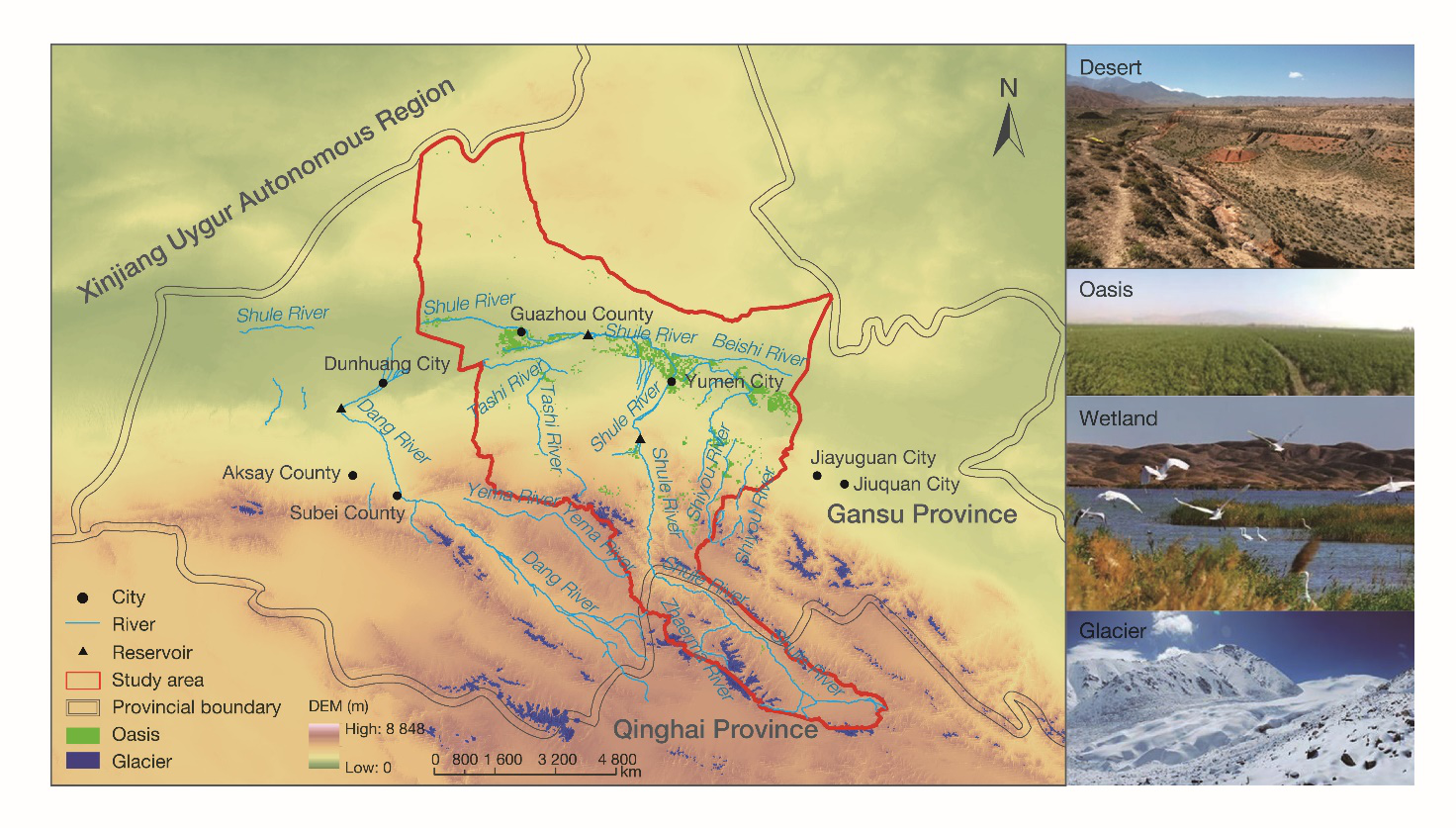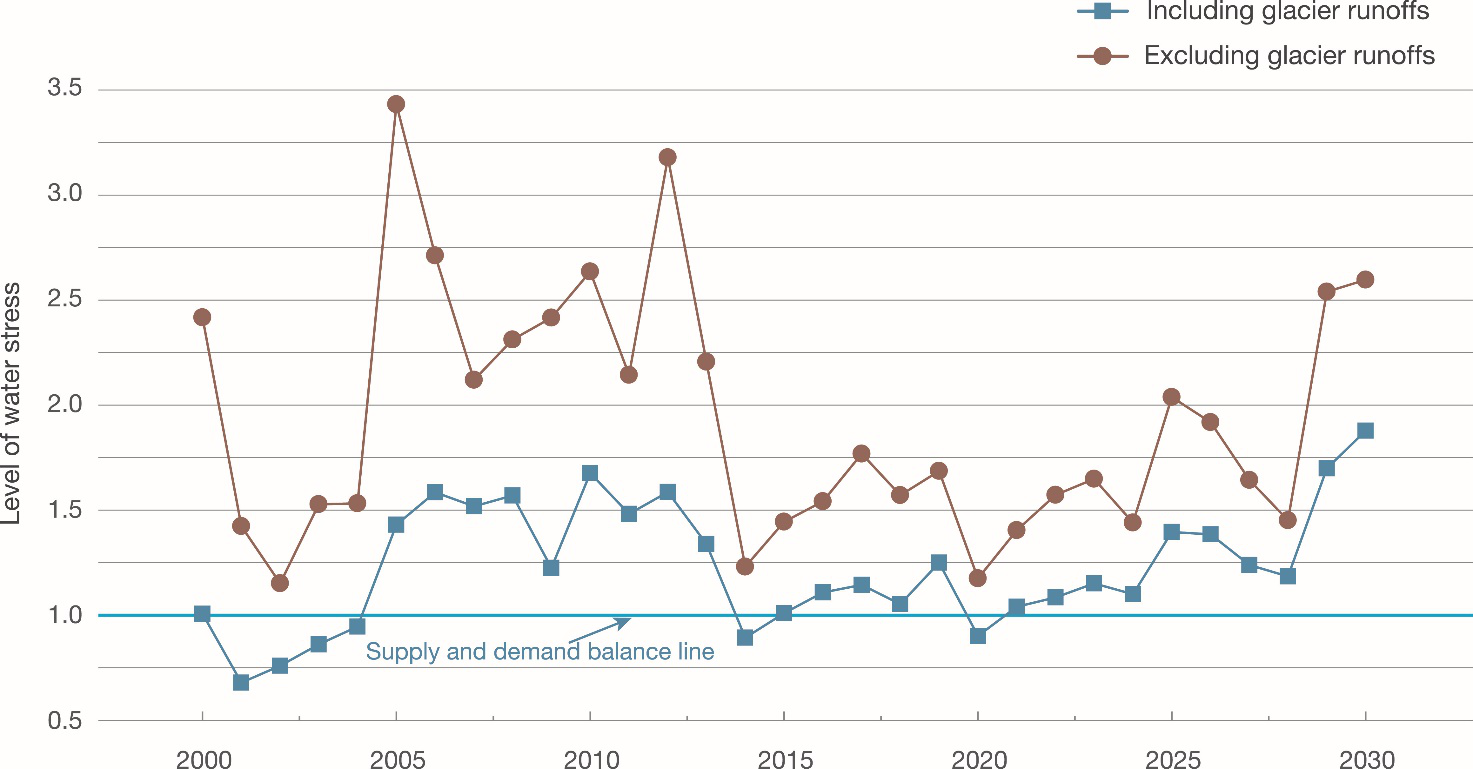SDG6: Clean Water and Sanitation
Evaluation of level of water stress in the Shule River basin in arid region, Northwest China(2020)
Target: 6.4 By 2030, substantially increase water-use efficiency across all sectors and ensure sustainable withdrawals and supply of freshwater to address water scarcity and substantially reduce the number of people suffering from water scarcity.
| Highlights |
| The average glacier meltwater contribution to the total runoff of the Shule River basin will decrease from the current 23% to 15% by 2030s (RCP 2.6 scenario). From 2015 to 2020, supply of fresh water resources has been close to the level of demand. Between 2021 and 2030, the level of water stress will increase. |
Background
As a solid body of water, glaciers play an extremely important role in the sustainable water use in the global arid area. The population of the arid areas highly dependent on glacial water resources is nearly 200 million. Against the background of global warming, mountain glaciers across the world have been melting at a faster pace, resulting in weaker capacity for continuous water supply to some arid areas, triggering a chain effect on the downstream ecological-social-economic systems, such as shortage of water for economic and social purposes, and increase in potential risks of desertification (Allan et al., 2019; Immerzeel et al., 2019).
LWS is the most direct indicator of water resource stress. Currently, however, a module is lacking for glacial runoff LWS, the correct assessment of which is a key to the accurate assessment of the LWS in the Global Glacier-Covered Arid Areas (GGCAAs).
The Shule River basin, located in the arid region of northwest China (it straddles Haibei Tibetan Autonomous Prefecture, Qinghai province and Jiuquan city, Gansu province), is a typical example of the GGCAAs (Fig. 1). The case calculated and simulated the total runoff, glacial runoff from the upper reaches of the Shule River basin, and basin socio-economic water demand, evaluated the basin's LWS from 2000 to 2030, and put forward policy recommendations on water resources security.

Figure 1. Spatial distribution of glaciers, runoffs, and oases in the Shule River basin
Data used
The First and Second Chinese Glacier Inventory (1970-2004; 2006-2011) .
Runoff data of Changmabao hydrological station from mountainous watershed in the Shule River basin.
Basin Statistical Yearbook, Social and Economic Bulletin and water demand indicators of basin primary, secondary, and tertiary industries during 2000-2018.
Method
The case analyzed the impact of glacial runoff changes on the LWS in the basin under Representative Concentration Pathway (RCP) 2.6 (a sustainable development scenario) and developed a new evaluation method of the LWS with coupling glacier module. The method (as shown below) can be used for the LWS calculation in the GGCAAs.

where the LWS is the level of water stress; S is the available fresh water resources; Dse is the social and economic water demand, including water needed for production (Dp), domestic consumption (Dd), and artificial ecosystems (Dae) (calculated by the water quota method); Rtotal is the watershed runoff; Dne is ecological baseflow (calculated by the hydrological index method, i.e. the ordinal "90%" observation year out of a list of the average flow of the driest month of each year in descending order). In arid basins, glacial runoff, accounting for a high proportion of the total in dry seasons, is of great significance for maintaining the ecological baseflow of rivers. The Nash efficiency coefficient and R2 index were selected to evaluate the simulations of upstream runoff in the basin from 1991 to 2013. The results showed fairly good simulation effects, with the Nash efficiency coefficient being 0.89 and R2 0.89 (Zhang et al., 2019).
Results and analysis
In the context of global warming, the increases in precipitation and glacial meltwater in the upper reach of the Shule River basin lead to an upward trend of the total upstream surface runoff. During the period 2000-2010, the average annual runoff was about 1.04×109 m3, of which the average annual glacial runoff was about 2.64×108 m3. Forecasts indicate that, compared with 2000-2010, the average runoff will increase by 22.8%, while the average glacial runoff will decrease by 11% from 2020 to 2030. The contribution of glacial meltwater to the SLR will be reduced from 23% at present to 15% by 2030s (RCP 2.6 scenario).
During the period 2000-2010, the average annual ecological baseflow in the Shule River basin was 4.20×108 m3, accounting for 40.6% of the average annual surface runoff. During the period from 2020 to 2030, it will decrease to 3.84×108 m3, accounting for 30.2% of the annual average surface runoff. Affected by the reduction of glacial runoff, the ecological baseflow in the Shule River basin has shown a downward trend. The annual available freshwater resources increased generally between 2000-2010, totaling 6.16×108 m3, and will increase by 44.2% to 8.88×108 m3 between 2020-2030 due to increase in precipitation.
From 2000 to 2004, the basin freshwater withdrawal was about 5×108 m3. It increased rapidly to 9.89×108 m3 from 2005 to 2014, due to resettlement and expansion of arable land, with the LWS hovering around 1.45. From 2015 to 2020, under the restriction of water use quota, there has been a basic equilibrium between supply and demand for water resources in the basin. If the current trend continues, during the period 2021-2030, annual freshwater withdrawal will continue to increase, and the LWS will rise (Fig. 2). Glacial runoff has contributed to an average reduction of the LWS by 0.71 from 2000 to 2030.

Figure 2. The changes of level of water stress in the Shule River basin in arid region of Northwest China
Outlook
Glacial runoff is important to the relief of water stress and sustainable development of eco-economic system in the GGCAAs. Glacial runoff has an obvious regulating effect on surface runoff. In the future, as the glacial meltwater runoff in the Shule River basin continues to decrease, its role in regulating and relieving water stress in the basin will be greatly weakened. In dry years with high temperature and low rainfall and years with large water withdrawals, the LWS in the basin may greatly increase. Higher agricultural irrigation water consumption and lower water use efficiency are the main factors leading to a certain level of water stress in the basin. In the future, strict control over arable land expansion, higher irrigation water use efficiency and developing efficient, water-saving agriculture hold the key to reducing freshwater withdrawal and maintaining the sustainable use of water resources in the GGCAAs.

